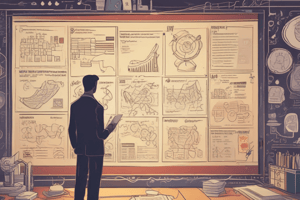Podcast
Questions and Answers
How does the 'Great Man' theory explain the acquisition of leadership qualities?
How does the 'Great Man' theory explain the acquisition of leadership qualities?
Leaders are born with genetically inherited superior qualities.
According to the Trait Theory of leadership, what is a key limitation?
According to the Trait Theory of leadership, what is a key limitation?
There is no universally accepted list of essential traits.
In the context of Behavioral Theories, briefly contrast autocratic and laissez-faire leadership styles.
In the context of Behavioral Theories, briefly contrast autocratic and laissez-faire leadership styles.
Autocratic leaders are sole authorities who make decisions unilaterally, while laissez-faire leaders allow followers freedom in how they work.
Name one advantage and one disadvantage of autocratic leadership according to Behavioral Theory.
Name one advantage and one disadvantage of autocratic leadership according to Behavioral Theory.
In the Managerial/Leadership Grid (Blake-Moulton), what does a leader with high concern for people and low concern for task emphasize?
In the Managerial/Leadership Grid (Blake-Moulton), what does a leader with high concern for people and low concern for task emphasize?
How does Hersey-Blanchard's Situational Leadership Theory define leadership behavior?
How does Hersey-Blanchard's Situational Leadership Theory define leadership behavior?
Describe the difference between 'telling' and 'delegating' in the Hersey-Blanchard Situational Leadership Model.
Describe the difference between 'telling' and 'delegating' in the Hersey-Blanchard Situational Leadership Model.
Briefly differentiate between McGregor's Theory X and Theory Y assumptions about employees.
Briefly differentiate between McGregor's Theory X and Theory Y assumptions about employees.
Give an example of the work environment for Theory X employees.
Give an example of the work environment for Theory X employees.
What is the main focus of Transactional Leadership compared to Transformational Leadership?
What is the main focus of Transactional Leadership compared to Transformational Leadership?
How do transactional and transformational leaders differ in motivating their followers?
How do transactional and transformational leaders differ in motivating their followers?
Explain how a cross-cultural leader ensures inclusivity and communication.
Explain how a cross-cultural leader ensures inclusivity and communication.
What is the primary focus of servant leadership?
What is the primary focus of servant leadership?
How does strategic leadership align organizational goals?
How does strategic leadership align organizational goals?
What's the primary difference in how Level 4 and Level 5 leaders view their companies' success?
What's the primary difference in how Level 4 and Level 5 leaders view their companies' success?
How do Level 4 and Level 5 leaders differ in their approach to success?
How do Level 4 and Level 5 leaders differ in their approach to success?
How do Level 4 and Level 5 leaders differ in their reaction to mistakes?
How do Level 4 and Level 5 leaders differ in their reaction to mistakes?
What fundamental practice defines AI-Augmented Leadership?
What fundamental practice defines AI-Augmented Leadership?
How is AI used to augment human leadership, and what's the key benefit?
How is AI used to augment human leadership, and what's the key benefit?
How does AI enhance the 'awareness' aspect of human leadership?
How does AI enhance the 'awareness' aspect of human leadership?
In what way does AI contribute to 'wisdom' in a leadership context?
In what way does AI contribute to 'wisdom' in a leadership context?
How can AI support 'compassion' in leadership roles?
How can AI support 'compassion' in leadership roles?
What is an example of a 'future-readiness' benefit of AI-Augmented Leadership?
What is an example of a 'future-readiness' benefit of AI-Augmented Leadership?
Name two core benefits of AI-Augmented Leadership regarding decision-making and efficiency.
Name two core benefits of AI-Augmented Leadership regarding decision-making and efficiency.
How does AI contribute to personalization in leadership approaches?
How does AI contribute to personalization in leadership approaches?
Flashcards
Great Man Theory
Great Man Theory
Leadership is genetically inherited with superior qualities.
Trait Theory
Trait Theory
Leaders possess a permanent set of individual qualities or traits.
Behavioral Theory
Behavioral Theory
It focuses on how leaders behave and assume that these traits can be learned.
Situational Theory
Situational Theory
Signup and view all the flashcards
Cross-Cultural Leadership
Cross-Cultural Leadership
Signup and view all the flashcards
Servant Leadership
Servant Leadership
Signup and view all the flashcards
Bureaucratic Leadership
Bureaucratic Leadership
Signup and view all the flashcards
Strategic Leadership
Strategic Leadership
Signup and view all the flashcards
Rock-star CEO
Rock-star CEO
Signup and view all the flashcards
Humble CEO
Humble CEO
Signup and view all the flashcards
AI-Augmented Leadership
AI-Augmented Leadership
Signup and view all the flashcards
Theory X
Theory X
Signup and view all the flashcards
Theory Y
Theory Y
Signup and view all the flashcards
Behavioral Theories
Behavioral Theories
Signup and view all the flashcards
Concern for People
Concern for People
Signup and view all the flashcards
Concern for Task
Concern for Task
Signup and view all the flashcards
Hersey-Blanchard Situational Theory
Hersey-Blanchard Situational Theory
Signup and view all the flashcards
Autocratic Leadership
Autocratic Leadership
Signup and view all the flashcards
Laissez-Faire Leadership
Laissez-Faire Leadership
Signup and view all the flashcards
Democratic Leadership
Democratic Leadership
Signup and view all the flashcards
Transactional Leadership
Transactional Leadership
Signup and view all the flashcards
Transformational Leadership
Transformational Leadership
Signup and view all the flashcards
Transactional Leadership Motivation
Transactional Leadership Motivation
Signup and view all the flashcards
Tranformational Leadership Motivation
Tranformational Leadership Motivation
Signup and view all the flashcards
Study Notes
Overview of Leadership Theories
- Focuses on the evolution of leadership theories as well as contemporary and emerging approaches.
- Includes Level 5 leadership, rockstar vs. humble CEO comparisons, and AI-augmented leadership.
Leadership Theories
- Great Man Theory (1840): Leadership is genetically inherited; leaders are born, not made. Associated with Thomas Carlyle and Galton.
- Leaders shape their nation according to their abilities and are intelligent, energetic, and superior to followers.
- Trait Theory (1930-1940): Leaders possess a permanent set of individual qualities, like courage, intelligence and empathy, which can be acquired. Stogdill is associated with this theory (1940).
- Limitations of Trait theory involve a lack of universally accepted traits and the fact that not all leaders have all traits.
- Behavioral Theory (1950): Examines leader-follower relationships and leadership styles.
- University of Iowa studies identified autocratic, democratic, and laissez-faire styles.
- University of Michigan studies identified employee-oriented and task-oriented leadership.
- Contingency and Situational Theory (1960): Leadership adapts to the situation. The Hersey-Blanchard Theory is associated with this.
- Interaction/Expectation Theory (1967): Includes McGregor's Theory X & Theory Y.
- Contemporary/Integrative Theory (Late 1970s): Focuses on transactional, transformational and charismatic leadership.
- Emerging Approaches: Includes strategic, cross-cultural, Level 5, servant, and bureaucratic leadership.
- AI-Augmented Leadership is also an emerging leadership theory.
Behavioral Theory Styles
- Autocratic: The leader is the sole authority who expects compliance and controls outcomes.
- Democratic: The leader allows team input, encourages participation, and acts as a guide.
- Laissez-Faire (Free Rein): The leader allows freedom in decision-making with minimal interference; offers support.
Autocratic Leadership
- Advantages: Enables quick decisions and suits less competent employees.
- Disadvantages: Can cause a lack of spirit, commitment, and limited skill development for subordinates.
Democratic Leadership
- Advantages: Highly motivating, increases job satisfaction and productivity, and helps develop leadership skills.
- Disadvantages: Is less effective when quick decisions are needed or when employees are less skilled.
Laissez-faire leadership
- Advantages: It is suitable where close oversight isn't required and helps in developing skills, plus quicker decision making.
- Disadvantages: Lacks leader input, may not yield the best results if employees are less skilled, and could damage followers' motivation.
Managerial/Leadership Grid (Blake-Moulton)
- Concern for People: The extent to which a leader considers team member needs and development.
- Concern for Task/Production: The degree to which a leader emphasizes objectives and productivity.
Situational/Contingency Theory (Hersey-Blanchard)
- Leadership behavior depends on the capability and motivation of followers.
- Capability Indicators: Previous experience, training, task understanding, and role awareness.
- Motivation Indicators: Confidence, responsibility, wish to accomplish tasks, and incentives.
Theory X & Y
- Theory X (Authoritarian): Assumes employees dislike work, leading to strict control.
- Theory Y (Participative): Assumes employees enjoy work, promoting empowerment.
- Theory X relies on extrinsic motivation (punishment/reward), while Theory Y relies on intrinsic motiviation (growth/fulfilment).
Contemporary Approaches to Leadership
- Transactional Leadership: Focuses on short-term goals, rewards, and structure.
- Transformational Leadership: Focuses on long-term vision, change, and inspiring motivation.
Emerging Approaches to Leadership
- Cross-Cultural Leadership: Adapts to diverse cultural backgrounds, ensuring inclusivity, for example, a multinational company CEO.
- Servant Leadership: Puts employees' and society's needs first for growth, for example, Sir Fazle Hasan Abed (BRAC).
- Bureaucratic Leadership: Follows strict rules and hierarchy for efficiency, for example, government bank executives.
- Strategic Leadership: Focuses on long-term vision, adaptability, and aligning goals, for example, leadership at BEXIMCO.
Level 4 vs Level 5 Leadership
- Level 4 (Rock-star CEO): Concerned with personal image, not succession; blames others for failures; and imposes their vision.
- Level 5 (Humble CEO): Concerned for the company's image, having a succession plan; takes responsibility; facilitates discussion.
AI-Augmented Leadership
- The practice of enhancing leadership with AI technologies for better decision-making and productivity.
- AI acts as a co-pilot, providing insights and automating tasks rather than replacing human leaders.
- AI enhances awareness by improving perceptual abilities of the mind.
- AI enhances wisdom by assisting leaders in making informed decisions and problem solving.
- AI promotes compassion by supporting empathy and compassion in leadership interactions.
- Core Benefits:
- Enhanced Decision-Making: AI provides data-driven insights, to help leaders make informed decisions.
- Operational Efficiency: AI's automation of repetitive tasks allows leaders to focus on strategy and innovation.
- Personalization: Improves engagement and productivity, as AI tailors leadership approaches to individual team needs.
- Future-Readiness: AI allows leaders to anticipate trends, disruptions, and opportunities through predictive analytics.
Studying That Suits You
Use AI to generate personalized quizzes and flashcards to suit your learning preferences.



